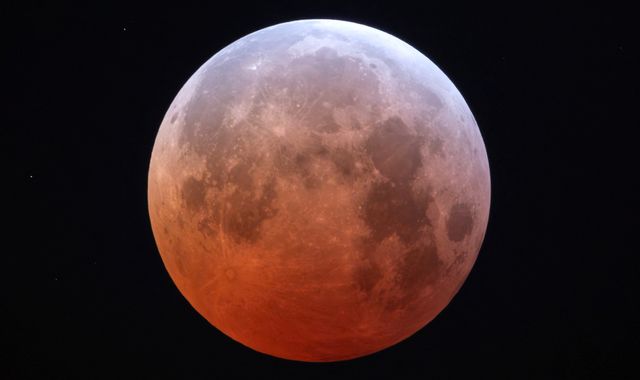
If you look up to the sky on Sunday, you might just see a rare celestial event - a total lunar eclipse.
The phenomenon occurs when the sun, Earth and the moon align perfectly with one another in a straight line.
As the moon passes through the darkest part of the Earth's shadow - known as the umbra - it causes it to turn a deep, dark red colour, creating what is known as a blood moon.
Lunar eclipses are not always 'total' and for UK observers, a total eclipse hasn't been visible since 2022, and won't occur again until August 2026.
Here is everything you need to know in order to catch a glimpse this weekend.
When is the blood moon?
The eclipse will begin while the moon is still below the UK's horizon.
This means that as it rises, it will already be in total eclipse. The Royal Observatory says the best time to see the blood moon is 7.33pm on Sunday.
It will continue to slowly move out of the Earth's shadow until 9.55pm, giving stargazers in the UK approximately two hours and 22 minutes to see the eclipse.
Those in easternmost Africa, the Middle East, most of Asia, and western Australia will be able to witness the entire event from start to finish, while UK observers will catch the latter stages.
What causes the red colour?
When the moon is in the Earth's umbra, it does not get any direct sunlight, meaning only light that is refracted through Earth's atmosphere manages to reach the moon.
Shorter blue wavelengths of light are typically scattered by the Earth's atmosphere, leaving longer red wavelengths to pass through - hence the red tones of the moon.
The more dust or clouds in Earth's atmosphere during the eclipse, the redder the moon appears, according to NASA.
This same atmospheric refraction effect is what causes sunsets and sunrises to look red.
How best to see it?
Unlike some celestial events, a blood moon can be seen with the naked eye, but astronomer Tom Kerss told the Royal Observatory some of his tips for how to improve your viewing experience:
• Know your horizon - the blood moon will be best for UK observers when the moon starts to rise in the west and southwest;
• Use a telescope to see details of the lunar surface;
• Tripods and or remote shutter lenses could help improve the quality of photographs.
In urban areas, people are encouraged to head to a hill or a high viewpoint to get the best view of the moon, which will appear low on the horizon line.
What is the weather going to be like?
According to the Met Office, much of England and Wales will see clear spells into the night, so should have good viewing conditions.
But, the weather forecaster added, visibility is set to be poorer in parts of northern England and Scotland as they are expected to hold on to cloudier skies and outbreaks of heavy rain into the evening and overnight.
Read more from Sky News:
Huge shortfall in NHS funding for weight-loss jab
One of the world's biggest icebergs is breaking up
Dr Ed Bloomer, an astronomer at the Royal Observatory Greenwich, said the moon will rise over the UK just in time for people to see the tail end of the eclipse.
"The moon is pretty unmistakable in the sky, so the most important thing is to face the right direction," Dr Bloomer said.
"It'll be rising towards the east, and head southwards over the course of the night.
"As it rises, the most important thing will be whatever is low on your horizon. A flat landscape, or an elevated position makes for the best visibility - literally so there aren't things like buildings, trees, or other things in the way.
"A lunar eclipse like this is a great opportunity for observing with kids too. It isn't too late for us in the UK, the target is nice and easy and minute by minute you will notice changes (good for short attention spans)."

(c) Sky News 2025: How to see the blood moon total lunar eclipse tonight














